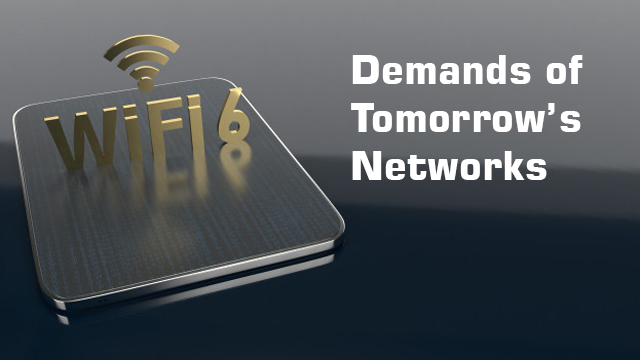Not only a technical aspect, but will change the business landscape. Wi-Fi 6 caters best to the needs and going to replace all previous generation Wi-Fi in a very short span of time,
Wi-Fi 6 changes the way Wi-Fi will work forevermore. Wi-Fi 6 will bring with it immediate benefits in network speed, capacity and responsiveness to the broad market – benefits that will improve over time as more Wi-Fi 6-capable devices that can make the most of the technologies’ many capabilities replace systems with older-generation connectivity.
Perhaps more importantly, Wi-Fi 6 brings network performance up to a level that will enable revolutionary new applications in virtually every segment. Some of those applications are already apparent. But many won’t arise for several years, until there is a critical mass of Wi-Fi 6 connectivity.
To best leverage the many benefits of Wi-Fi 6 connectivity – today, and in the future – buyers would be wise to choose the best technology available for their deployments. Platforms available today that supports 8×8 MU-MIMO and OFDMA with up to 37 simultaneous users, both spec maximums. As well, the Networking Pro’s internal scheduling architecture – which is fully compatible with the standard – is ready for the demands of tomorrow’s networks, with 100s of devices connecting simultaneously.
Wi-Fi is about to get faster and faster internet is constantly in demand, especially as we consume more bandwidth-demanding apps, games, and videos with our laptops and phones.
But the next generation of Wi-Fi, known as Wi-Fi 6, isn’t just a simple speed boost. Its impact will be more nuanced, and we’re likely to see its benefits more and more over time.
HOW FAST IS WI-FI 6?
Wi-Fi 6 is the next generation of Wi-Fi. It’ll still do the same basic thing — connect you to the internet — just with a bunch of additional technologies to make that happen more efficiently, speeding up connections in the process.
It will be upo to 9.6 Gbps which is currently at 3.5 Gbps on Wi-Fi 5.
The real answer: both of those speeds are theoretical maximums that you’re unlikely to ever reach in real-world Wi-Fi use. And even if you could reach those speeds, it’s not clear that you’d need them. The typical download speed in the US is just 72 Mbps, or less than 1 percent of the theoretical maximum speed. But the fact that Wi-Fi 6 has a much higher theoretical speed limit than its predecessor is still important. That 9.6 Gbps doesn’t have to go to a single computer. It can be split up across a whole network of devices. That means more potential speed for each device.
CURRENT CHALLENGES OF WIFI 6
According to Mr. Vinay Shetty – ASUS Regional Director, Components Business – India and South Asia, Some of the very evident challenges in light of everyone working/studying from home are – a slow and unstable connection, the coverage area, increasing need for online security and number of connected devices to a single router at any given point of time.
“Wi-Fi is the primary network and a mission-critical resource for the organizations Poor Wi-Fi is no longer simply an inconvenience; it means lost customers, degraded customer experiences, lost revenue and brand damage. Taking about the challenges, I feel there have been a plenty with regards to Wi-Fi as it in an in-air technology. Mainly common challenges faced these days arre Wi-Fi Dead Spots, Slow and Unstable Connection, inefficient Bandwidth Usage, Connection Safety and Cyber Security etc,” said, Mr. Samir Kamat, Head of Systems Engineering, Digisol.
 Mr. Samir Kamat, Head of Systems Engineering, Digisol
Mr. Samir Kamat, Head of Systems Engineering, Digisol
” During the pandemic, many of us were forced to work from our homes or the schools were pushed from classrooms to online. At home Wi-Fi has become an integral part of every home during this pandemic and many of our activities are done from our home we require a good and stable Wi-Fi connectivity which can limit our daily online activities,” said, Alok Verma, Manager, Marketing, Tenda India Pvt. Ltd.
“WiFi 6 – or 802.11ax – is the latest and the best wireless networking standard and its arrival means that users won’t need to be kept waiting for their devices to respond in higher density environments. With WiFi 6 there is no contention, no waiting, no degradation in performance. This improvement – along with the much faster, multi-gigabit speeds that it delivers – make WiFi 6 a great technology for any organization that often has many users and devices connected simultaneously. The major challenge we face in the WiFi is the slow and unstable connectivity along with connection safety and cyber security,” added, Mr. Gary Chen, Managing Director at Zyxel India.
 Mr. Gary Chen, Managing Director at Zyxel India
Mr. Gary Chen, Managing Director at Zyxel India
“With the growing number of devices, the existing Wi-Fi devices are facing challenges to handle the load and provide efficient Wi-Fi connectivity and larger home required Wi-Fi solutions with high performance in every nook and corner of the house. During the pandemic, many of us were forced to work from our homes or the schools were pushed from classrooms to online. As home Wi-Fi has become an integral part of every home during this pandemic and many of our activities are done from our home we require a good and stable Wi-Fi connectivity which doesn’t hamper our daily online activities,” said, Mr. Marthesh Nagendra, Country Manager India, ME & SAARC, NETGEAR.
 Mr. Marthesh Nagendra, Country Manager India, ME & SAARC, NETGEAR
Mr. Marthesh Nagendra, Country Manager India, ME & SAARC, NETGEAR
“ WIFI in terms of the networking industry has grown to be a must haves for a living – Roti / Kapda / Makaan and now WiFi. Though this is a fast growing technology getting it right in selecting the adequate device is still in a learning stage in India. Compatibility of all devices on the same technology level, and understanding the placement of the devices etc. are some of the basic challenges faced in WiFi application,” said, Bijoy Alaylo, VP Channel Sales, TP-Link.
“The current scenario has made internet an essential feature of our life. Earlier, only computing devices were connected to Wi-Fi networks. But most households today have multiple devices that are connected to the Wi-Fi. With advancement of technology & smart living becoming a reality, more and more devices at home with IoT features are being connected to Wi-Fi – be it light bulb, washing machines, dishwasher, 8K TV etc. However, all these devices need different bandwidths and response time to operate optimally. For all these devices to work in harmony a stable, accommodative, adaptive, and multifunctional Wi-Fi network is crucial.
To give you an example – device like 8K TV needs high speed and low latency bandwidth, while a Wi-Fi bulb would need bandwidth in Kbps. So handling multiple bandwidth intensive devices on the same network can be a challenge. Further devices working in lower frequencies like 2.4 Ghz with limited channels would attract lots of EMI /RFI noise, resulting in Wi-Fi network congestion. Infact congestions in the wireless channels can lower the reliability of connectivity and increase latency in entire network.
Legacy products (enabled 11g and 11n) working with low bandwidth can hold high bandwidth products eventually, but the network come under slow response resulting in bad performance. Another crucial concern with Legacy Wi-Fi networks at home or office is that it is vulnerable to cyber threats due to weak passwords and simple encryption mechanisms. Overall third and fourth generation Wi-Fi networks are not intelligent enough to adapt such vulnerable to unpredictable wireless performance challenges, concluded, Mr. Raj Jadhav, Vice President – Solution Consulting, Product Engineering & IT at D-Link (India) Ltd.
 Mr. Raj Jadhav, Vice President – Solution Consulting, Product Engineering & IT at D-Link (India) Ltd.
Mr. Raj Jadhav, Vice President – Solution Consulting, Product Engineering & IT at D-Link (India) Ltd.
OPINION ON WIFI 6
“ Wi-Fi-6 is the next generation of indoor wireless technology, also known as IEEE 802.11ax The Wi-Fi Alliance began designating 802.11ac technology and the devices that support it — as Wi-Fi 5. That’s the current standard, and it’s about seven years old. What we need to know and comprehend is that Wi-Fi 6 will be faster and much more efficient, capable of powering a growing number of devices simultaneously — iPads, laptops, smart TVs, video-game consoles, connected kitchen appliances, virtual-reality platforms and so on. Wi-Fi 5 can handle some but not all those at once, leading to network congestion and slowdowns as the device in our homes battle for bandwidth. Some households may be getting a taste of this because of the pandemic. For instance, one parent is trying to conduct a Zoom video conference call from a laptop, while another streams Netflix and the kids use their tablets to attend virtual school lessons or play online games,” said, Mr. Samir Kamat, Head of Systems Engineering., Digisol.
“Wi-Fi 6 is a major upgrade in Wi-Fi technology so far. While IT resolves long awaited teething issues in wireless networks to stand with wired networks, Wi-Fi 6 brings an array of benefits for today’s bandwidth hungry network users. Wi-fi 6 is quite faster than its predecessor variants due to traffic priority, Orthogonal Frequency division multiplexing (OFDMA) and beamforming like features. Essentially Wi-Fi 6 helps in better connectivity when there are multiple devices hooked on the same network. Also, it is not just the speed that everyone is raving about as Wi-Fi 6 also means better security. In terms of password security, Wi-Fi 6 is quite robust due to the latest encryption technologies like Simultaneous Authentication of Equals (SAE). Further devices with latest upgrade in Wifi-6 can utilise 6Ghz frequency band to enhance the speed and connectivity, opined, Mr. Raj Jadhav, Vice President – Solution Consulting, Product Engineering & IT at D-Link (India) Ltd.
“Wi-Fi 6 (802.11ax) is expected to transform the smart devices ecosystem in India as more devices demanding high bandwidth are getting added to the home and enterprise networks. Wi-Fi 6 incorporates key 5G technologies such as OFDMA and MU-MIMO; thus it finds more relevance in 5G-powered applications. However, significant technology and device upgrade is required for enabling Wi-Fi 6 across service provider and enterprise networks, which could emerge as a key challenge in its adoption. Also, the benefits of Wi-Fi 6 can only be achieved if the outside network delivers comparable speed, so the availability of spectrum and fiber emerges as an important factor in driving the adoption of Wi-Fi 6, said, Anku Jain, Managing Director, MediaTek India.
 Mr. Anku Jain, Managing Director, MediaTek India
Mr. Anku Jain, Managing Director, MediaTek India
“WiFi6 increases the capacity of a wireless network by between 200-500%. Faster speed – connections will be as much as 25% faster. Smoother and clear voice and video calls, conference sessions and streaming. Consistent performance- for every user, every time, no matter how many devices are connected. In my opinion, WiFi6 is the future of networking industry,” said, Gary Chen, Managing Director at Zyxel India.
“ As data needs and the number of connected devices continue to skyrocket , network technologies have to keep up with the speed, complexity, and congestion that follow. Hence Wifi-6 is the need of the hour and the more all the brands shift to Wifi-6 the better for consumers,” said, Bijoy Alaylo, VP Channel Sales, TP-Link.
 Mr. Bijoy Alaylo, VP Channel Sales, TP-Link
Mr. Bijoy Alaylo, VP Channel Sales, TP-Link
“Wi-Fi 6 is gaining popularity and many devices are launching with it and are also already quite popular within users. With more Wi-Fi coverage increasing and an increased number of devices catering to it, Wi-Fi 6 caters best to these needs and going to replace all previous generation Wi-Fi in a very short span of time, said, Alok Verma, Manager, Marketing, Tenda India Pvt. Ltd.
“ Wi-Fi6 is already quite popular within users and more deployments are happening on Wi-Fi6. With Wi-Fi environment becoming more demanding with an increased number of devices and more coverage area, Wi-Fi 6 caters best to these needs and going to replace all previous generation Wi-Fi in a very short span of time,” said, Marthesh Nagendra, Country Manager India, ME & SAARC, NETGEAR.
“ Technology evolves and the Wi-Fi 6 standard is a leap in the world of networking technology. Wi-Fi 6 technology offers more capacity and bandwidth than the earlier Wi-Fi standards (Wi-Fi 4, 5). This means multiple devices connected to a single router on a single network,” concluded, Mr. Vinay Shetty – ASUS Regional Director, Components Business – India and South Asia
 Mr. Vinay Shetty – ASUS Regional Director, Components Business – India and South Asia
Mr. Vinay Shetty – ASUS Regional Director, Components Business – India and South Asia
DEPLOYMENT CONDITIONS
“As mentioned earlier Wi-Fi 6 is a major upgrade in terms of wireless technology, so anyone looking at switching their network with compatible hardware to Wi-Fi 6 will experience superlative speed and performance. Rise in adoption of Wi-Fi 6 technology is evident with many smart phone and laptop companies having already started shipping devices that are Wi-Fi 6 enabled, and thereby prompting customers to switch to new wireless standard. In near future it will be imperative for people to replace their existing previous generation Wi-Fi routers with the latest Wi-Fi 6 routers, as Wi-Fi6 has become the new normal for your wireless connectivity,” said, Mr. Raj Jadhav, Vice President – Solution Consulting, Product Engineering & IT at D-Link (India) Ltd.
“ Wi-Fi 6 is now moving rapidly to commercial deployment internationally as more and more 5G mobile networks are getting deployed in those regions. However, in India the IT infrastructure and the mobile technology is not yet upgraded since we do not have the 5G mobile networks to complement. The existing 4G mobile networks are suitable enough and complement well with the Wi-Fi 4 and Wi-Fi 5 networking devices,” said, Mr. Samir Kamat, Head of Systems Engineering., Digisol.
“802.11ax (Wifi 6) is more deterministic, including in terms of latency and throughput. The main point of Wifi-6 is not speed. The congestion and capacity issues that occur when “a large number of devices” are connected to a network are resolved through devices compatible with Wifi-6.,” said, Bijoy Alaylo, VP Channel Sales, TP-Link.
“Majorly dense environments like cities with a large number of Wi-Fi usages would be beneficial with Wi-Fi 6 deployments,” added, Alok Verma, Manager – Marketing, Tenda India Pvt. Ltd.
 Mr. Alok Verma, Manager – Marketing, Tenda India Pvt. Ltd
Mr. Alok Verma, Manager – Marketing, Tenda India Pvt. Ltd
“Majorly dense environments with a large number of Wi-Fi clients would be beneficial with Wi-Fi6 deployments. With more number of channels and OFDMA technology, the overhead of the overall Wi-Fi environment would be amortized among users. This leads to efficient use of resources and scales resources for different types of traffic (example: Instant messaging and large file download),” said, Marthesh Nagendra, Country Manager India, ME & SAARC, NETGEAR.
BIG IMPROVEMENTS OF WIFI 6
According to, Bijoy Alaylo, VP Channel Sales, TP-Link. In theory, a WiFi 6 capable router could hit speeds over 250% faster than current WiFi 5 devices. MU-MIMO, which stands for “multi-user, multiple input, multiple output,” is already in use in modern routers and devices, but Wi-Fi 6 upgrades it.Another new technology in Wi-Fi 6 allows devices to plan out communications with a router, reducing the amount of time they need to keep their antennas powered on to transmit and search for signals. That means less drain on batteries and improved battery life in turn.
“ Wi-Fi 6 Standard offers greater speed, lower latency, stronger security, and can connect 2x the device capacity. The proposed release of the 6 GHz band (Wi-Fi 6E) would mean that we can deliver advanced wireless services to consumers, businesses and industries,” said, Mr. Vinay Shetty – ASUS Regional Director, Components Business – India and South Asia.
According to Mr. Samir Kamat, Head of Systems Engineering., Digisol the Big Improvements of WIFI 6 are:
1- THE MU-MIMO TECHNOLOGY (MULTI USER – MULTIPLE INPUT AND MULTIPLE OUTPUT)
This technology, already used on a large part of current routers, will be generalized on all Wi-Fi 6 routers. It allows information to be sent to several devices at the same time rather than to each device one after the other. In addition, MU-MIMO is being updated with Wi-Fi 6. So far capable of communicating with 4 devices at a time, Wi-Fi 6 will allow communication to 8 devices at the same time.
2- OFDMA (ORTHOGONAL FREQUENCY DIVISION MULTIPLE ACCESS)
Wi-Fi 6 also relies on OFDMA which not only speeds up data transfer but also reduces latency. This technology allows data to be transmitted to several devices in a single transmission. Each transmission will be therefore optimized to contain a maximum of information per shipment.
3- TWT (TARGET WAKE-UP TIME)
It is an intelligent standby mode to reduce the energy consumption of the access point, but also to limit interference with nearby devices.
Mr. Alok Verma, Manager, Marketing, Tenda India Pvt. Ltd., pointed out the Wi-Fi 6 offers the following major improvements, like, Offers increased capacity for growing smart homes, Reduced interference from other devices, Faster speed, Better coverage range and Longer battery life for mobile and smart home sensors.
Mr. Marthesh Nagendra, Country Manager India, ME & SAARC, NETGEAR also offers the following major improvements, such as, Offers Up to 4X increased capacity for growing smart homes, Reduced interference from other devices, Faster speed – better range, Longer battery life for mobile and smart home sensors and Backward compatible with all existing Wi-Fi devices.
“ Data rate increase 25%, 1024-QAM (The newest modulation standard with each coding symbol containing more bytes of data than 256-QAM resulting in a 25% data rate increase. Data transfer speed (10 Gbps WiFi capability), Power efficiency , target wake-up time (The AP coordinates transmission times from different sources, allowing devices to sleep during the non-transmission periods since there is no need to be awake and monitor beacons sent by the AP,” said, Gary Chen.
FACTORS THAT WILL DRIVE THIS TECHNOLOGY
According to Mr. Raj Jadhav, Vice President – Solution Consulting, Product Engineering & IT at D-Link (India) Ltd, Wi-Fi 6 is a big leap in wireless technology in comparison to its predecessor. The latest Wireless standard is equipped with very advanced techniques to improve glitches that hamper throughput, congestions, and security. These cutting-edge advancements have led to increasing popularity and demand for Wi-Fi 6 amongst users. Today most device makers are providing gadgets/devices that readily support Wi-Fi 6. Another noteworthy point is that the latest Wi-Fi 6 Access points and routers available in the market are capable of connecting intelligently with legacy wi-Fi devices.
Taking the current scenario into account wherein Work from Home (WFH) has become a new norm, and with multiple devices being connected to our single home network it makes perfect sense for consumers to upgrade their existing 11n and 11AC Access points and routers to WiFi-6 capable devices for uninterrupted network connection & efficient working. While we do see a lot of active devices with customers still have 3rd and 4th generation Wi-Fi, upgrading them to Wi-Fi6 would give the scalability and performance capability for next 5 years which in my opinion will help derive significant benefits.
“ A stable internet signal, transfer speeds, rise in online content consumption, increase in number of connected devices will push the customer to adapt Wi-Fi 6 technology. Most of the latest generation of phones are being manufactured to support this Wi-Fi 6 standard plus the newly launched PS5 comes with Wi-Fi 6 in built. Wi-Fi 6 routers are also 100% backward compatible with previous standards, “ said, Mr. Vinay Shetty – ASUS Regional Director, Components Business – India and South Asia.
“Wi-Fi 6 has many upgrades in terms of technical features like it is designed to relive the network congestions, it supports multiple users, it enhances throughput. Better throughout offered by Wi-Fi 6 supports high resolution videos content streaming, smooth transfer of large file etc. Maximum throughput can be achieved by Wi-Fi 6 is 9.6 Gbps across multiple Channels, this is 3 times increase in comparison to previous Wi-Fi standard. Wi-Fi 6 adopts different techniques like efficient data encoding and intelligence in optimising wireless spectrum with help of high-speed processors which is crucial for very high transfer speed. Further latency with Wi-Fi 6 network is as good as wired networks as there is almost 75% improvement in the latency compared to the previous Wi-Fi standards. Another noteworthy feature is that Wi-Fi 6 devices reduce power consumptions due to TWT (Target Wake Time). Then there are multiple value-added features like Overlapping Basic Services Sets (OBSS) that helps to improve the network congestions unlike old devices which used a carrier sense multiple access method. OBSS enables Wi-Fi routers to use a colour to recognise network resulting in better reliability and improves the latency. Beamforming is one more technique in Wi-Fi 6 to improve the directional broadcast instead of uniform broadcasting, said, Mr. Raj Jadhav, Vice President – Solution Consulting, Product Engineering & IT at D-Link (India) Ltd.
Mr. Samir Kamat, Head of Systems Engineering., Digisol, pointed out the following factors:
Performance: Wi-Fi-6 offers up to four times the speed of 802.11ac. Other improvements include the ability to use the 2.4GHz and 5Ghz bands for a number of use cases.
Increasing density of devices: The Wi-Fi-6 network will be more efficient, faster and the user experience will be significantly improved.
Diversity of applications: Wi-Fi 6 can support growing number of devices simultaneously — iPads, laptops, smart TVs, video-game consoles, connected kitchen appliances, virtual-reality platforms and so on.
“ The Wi-Fi 6 technology can be driven to due to following factors, like, Increased number of client devices, Battery life increase of client devices, Faster speed and Better range, said, Mr. Alok Verma, Manager, Marketing, Tenda India Pvt. Ltd.
“ Speed, Stability and performance of device compatible with WiFi 6 is what will drive this tech forward. Today’s world need these 3 factors in any of the devices they search for. With technology growing heavier on devices the features having lighter effect on the battery life of a device or clearing network congestion are a boon to anyone wanting to upgrade,” concluded, Bijoy Alaylo, VP Channel Sales, TP-Link
EMERGING TREND
“ New infrastructural and security changes with the latest Wi-FI security WPA3 to become mandatory for all Wi-Fi certified products. Wi-Fi use in the drone and health care industry will shake up and change the way we interact with smart devices and technology. I am hoping that in due course of time that we can see Wi-Fi 6 being adopted in public spaces like airports, train stations, malls etc. I am certain that number of smart devices and tech in 2021 will see a massive surge,” said, Mr. Vinay Shetty – ASUS Regional Director, Components Business – India and South Asia.
“Recent efforts towards promoting Digitization and the outbreak of Pandemic has led to mass adoption of Wireless technology. Infact today most users (a single user) have at least 3 to 4 devices that are connect to the internet wirelessly. Then we have multiple such users connected to the same wireless network for high/low bandwidth activity. In a scenario like this we have wide number of active devices congesting the traditional Wi-Fi network due to which users experience constant buffering, while this also results in wastage of time and money. So, its apt to say that the pandemic has made us realize the significance of reliable Wi-Fi network which can accommodate – high speed connectivity, high resolution video conferencing, responsive audio conferencing and most importantly an uninterrupted network. Many applications related to infotainment, health care, webinars and team group meetings are driving the adoption of high speed, congestion free and reliable Wifi6 network and connectivity, said, Mr. Raj Jadhav, Vice President – Solution Consulting, Product Engineering & IT at D-Link (India) Ltd.
“Wi-Fi 6 products in most computer networking brands, Wi-Fi 6E in 6 GHz, Evolving WPA3 security, Wi-Fi as infrastructure for mission critical applications and Wi-Fi for ambient computing applications,” said, Mr. Samir Kamat, Head of Systems Engineering., Digisol.
“MediaTek delivers Wi-Fi 6 solutions with its intelligent chipset designed for a range of products including wireless access points, routers, gateways and repeaters. The Wi-Fi 6 technology lets routers schedule check-ins with multiple devices and sends data simultaneously in the same broadcast. We foresee great opportunity in this segment, as there is a growing demand for improved connectivity from applications like public Wi-Fi, gaming, HD video streaming, enterprise collaboration, smart city networks and more. With Wi-Fi 6, we could anticipate up to 50 devices simultaneously connected in the near future. The industry needs to adapt to this technology and make headway in delivering data-intensive applications across a wide range of consumer and industry segments,” said, Mr. Anku Jain, Managing Director, MediaTek India:
“ Mobile computing becomes real, 5G dynamic spectrum sharing, CBRS drives private cellular networks and Wireless SD-WAN with 5G, “ added, Mr. Alok Verma, Manager, Marketing, Tenda India Pvt. Ltd.
“Mobile Gaming will get a boost as gaming today is more LAN based. With WIFI getting faster and more stable this will be more beneficial for gamers. Security feature will be need upgradation as WIFI 6 takes up the market. Trends developing in India after introduction of more products in WIFI 6 were the data usage through mobile / OTT platform. This will keep increasing as still India is still to be completely covered with Internet everywhere,” said, Mr. Bijoy Alaylo, VP Channel Sales, TP-Link.
Finally
While WiFi6 may be the most appropriate choice for certain scenarios, the most successful adopters are likely to be those with the ability to deploy multiple technologies and know how to make diverse networks interoperate as needed.



